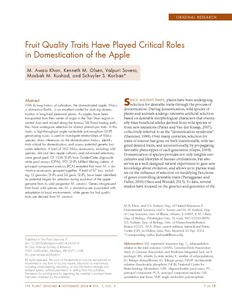With its long history of cultivation, the domesticated apple, Malus × domestica Borkh., is an excellent model for studying domestication in long‐lived perennial plants. As apples have been transported from their center of origin in the Tian Shan region in central Asia and moved along the famous Silk Road trading path, they have undergone selection for distinct phenotypic traits. In this study, a high‐throughput single nucleotide polymorphism (SNP) genotyping assay is used to investigate relationships of Malus species, draw inferences on the domestication history, identify traits critical for domestication, and assess potential genetic loci under selection. A total of 160 Malus accessions, including wild species, old and new apple cultivars, and advanced selections, were genotyped. Of 1536 SNPs from GoldenGate oligonucleotide pool assays (OPAs), 901 SNPs fulfilled filtering criteria. A principal component analysis (PCA) revealed that most M. × domestica accessions grouped together. A total of 67 loci, including 13 genomic SNPs and 54 genic SNPs, have been identified as potential targets for selection during evolution of the apple genome from its wild progenitor M. sieversii. Genes introgressed from local wild species into M. × domestica are associated with adaptation to local environments, while genes for fruit quality traits are derived from M. sieversii.
Fruit Quality Traits Have Played Critical Roles in Domestication of the Apple
Citation: Khan, M.A.; Olsen, K.M.; Sovero, V.; Kushad, M.M.; Korban, S.S. 2014. Fruit quality traits have played critical roles in domestication of the apple. Linkage disequilibrium . Genome-wide association analysis. The Plant Genome.
2015-04-02
journal_article

